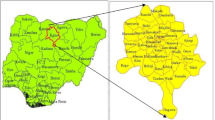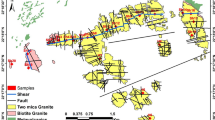Abstract
All over the world people are using different hard rocks as ornamental building stones. Information regarding the activity concentration rates for such rocks is very scarce, despite their environmental hazards. Therefore, samples of one of the most spectacular dotted granite were collected from Mueilha area located in the South Eastern Desert, Egypt. The activity concentrations were measured using high-purity germanium detector, and the inductively coupled plasma mass spectroscopy together with the atomic emission spectroscopy techniques were used for the chemical analyses of the samples. Furthermore, the rare earth elements (REEs) of the studied rocks were determined to study the expected economic benefits. It was found that the average concentration values of the radioisotopes (238U, 226Ra, 232Th and 40K) were above the worldwide average in building materials. Distinct variations between the calculated radiological hazards and the corresponding reference values were observed, where some indices had values greater than the world average, e.g. internal hazard index (Hin), annual gonadal dose equivalent (AGDE) and the excess lifetime cancer risk (ELCR), while some others had values lower than the world average, e.g. radium equivalent activity index (Raeq), the gamma representative level index (Iγ) external hazards index (Hex) and the indoor absorbed dose rate (ADR). These variations indicate to the difficulty of using these rocks as a bulk building material.


















Similar content being viewed by others
References
Abu El-Rus MA, Mohamed MA, Lindh A (2017) Mueilha rare metals granite, Eastern Desert of Egypt: an example of a magmatic-hydrothermal system in the Arabian-Nubian Shield. Lithos 294:362–382
Agbalagba E, Osakwe R, Olarinoye I (2014) Comparative assessment of natural radionuclide content of cement brands used within Nigeria and some countries in the world. J Geochem Explor 142:21–28
Al-Trabulsy H, Khater A, Habbani F (2011) Radioactivity levels and radiological hazard indices at the Saudi coastline of the Gulf of Aqaba. Radiat Phys Chem 80:343–348
Al-Zahrani J (2017) Estimation of natural radioactivity in local and imported polished granite used as building materials in Saudi Arabia. J Radiat Res Appl Sci 10(3):241–245
Beretka J, Mathew P (1985) Natural radioactivity of Australian building materials, industrial wastes and by-products. Health Phys 48:87–95
Blatt H, Tracy R (1997) Petrology, 2nd edn. Freeman, New York
Buonanno G, Giovinco G, Morawska L, Stabile L (2015) Lung cancer risk of airborne particles for Italian population. Environ Res 142:443–451
d’Aquino L et al (2009) Effect of some rare earth elements on the growth and lanthanide accumulation in different Trichoderma strains. Soil Biol Biochem 41:2406–2413
EC (1999) Radiation protection unit, radiological protection principles concerning the natural radioactivity of building materials. Radiat Prot 112
ICRP (1977) International commission on radiological protection: ICRP publication 26: recommendations of the international commission on radiological. Pergamon Press, Oxford
ICRP (1994) Protection against Radon-222 at home and at work
Kamel AF (1983) Relationship between photolineaments and radioactivity in Gebel El Mueilha, Central Eastern Desert, Egypt. J Afr Earth Sci (1983) 1:343–347
Krisiuk E, Tarasov S, Shamov V, Shalak N, Lisachenko E, Gomelsky L (1971) A study on radioactivity in building materials Research Institute for Radiation Hygiene, Leningrad 144
Krstić D, Nikezić D, Stevanović N, Vučić D (2007) Radioactivity of some domestic and imported building materials from South Eastern Europe. Radiat Meas 42:1731–1736
Mamont-Ciesla K, Gwiazdowski B, Biernacka M, Zak A (1982) Radioactivity of building materials in Poland. In: Vohra G, Pillai KC, Sadavisan S (eds) Natural radiation environment. Halsted Press, New York, p 551
McDonough WF, Sun S-S (1995) The composition of the Earth. Chem Geol 120:223–253
Nordic (2000) Naturally occurring radiation in the Nordic countries—recommendations. The radiation protection authorities in Denmark Finland. Iceland, Norway and Sweden, Reykjavik
Obeid M, Ali M, Mohamed N (2001) Geochemical exploration on the stream sediments of Gabal El Mueilha area, central Eastern Desert, Egypt: an overview on the rare metals. Resour Geol 51:217–227
Papadopoulos A, Christofides G, Koroneos A, Papadopoulou L, Papastefanou C, Stoulos S (2013) Natural radioactivity and radiation index of the major plutonic bodies in Greece. J Environ Radioact 124:227–238
Qu Y, Lian B (2013) Bioleaching of rare earth and radioactive elements from red mud using Penicillium tricolor RM-10. Bioresour Technol 136:16–23
Ravisankar R, Chandramohan J, Chandrasekaran A, Jebakumar JPP, Vijayalakshmi I, Vijayagopal P, Venkatraman B (2015) Assessments of radioactivity concentration of natural radionuclides and radiological hazard indices in sediment samples from the East coast of Tamilnadu, India with statistical approach. Mar Pollut Bull 97:419–430
Ravisankar R, Raghu Y, Chandrasekaran A, Gandhi MS, Vijayagopal P, Venkatraman B (2016) Determination of natural radioactivity and the associated radiation hazards in building materials used in Polur, Tiruvannamalai District, Tamilnadu, India using gamma ray spectrometry with statistical approach. J Geochem Explor 163:41–52
Righi S, Bruzzi L (2006) Natural radioactivity and radon exhalation in building materials used in Italian dwellings. J Environ Radioact 88:158–170
Sam A, Abbas N (2001) Assessment of radioactivity and the associated hazards in local and imported cement types used in Sudan. Radiat Prot Dosim 93:275–277
Svoukis E, Tsertos H (2006) Indoor and outdoor in situ high-resolution gamma radiation measurements in urban areas of Cyprus. Radiat Prot Dosim 123:384–390
Todorović N, Hansman J, Mrđa D, Nikolov J, Kardos R, Krmar M (2017) Concentrations of 226Ra, 232Th and 40K in industrial kaolinized granite. J Environ Radioact 168:10–14
Tzortzis M, Tsertos H, Christofides S, Christodoulides G (2003a) Gamma-ray measurements of naturally occurring radioactive samples from Cyprus characteristic geological rocks. Radiat Meas 37:221–229
Tzortzis M, Tsertos H, Christofides S, Christodoulides G (2003b) Gamma radiation measurements and dose rates in commercially-used natural tiling rocks (granites). J Environ Radioact 70:223–235
UNSCEAR (1993) Sources and effects of ionizing radiation UNSCEAR 1993 report to the general assembly, with Scientific Annexes
UNSCEAR (2000) Sources and effects of ionizing radiation: sources, vol 1. United Nations Publications, New York
Uosif M, Issa SA, El-Salam LA (2015) Measurement of natural radioactivity in granites and its quartz-bearing gold at El-Fawakhir area (Central Eastern Desert), Egypt. J Radiat Res Appl Sci 8:393–398
Xinwei L (2005) Natural radioactivity in some building materials of Xi’an, China. Radiat Meas 40:94–97
Xinwei L, Lingqing W, Xiaodan J, Leipeng Y, Gelian D (2005) Specific activity and hazards of Archeozoic-Cambrian rock samples collected from the Weibei area of Shaanxi, China. Radiat Prot Dosim 118:352–359
Xinwei L, Lingqing W, Xiaodan J (2006) Radiometric analysis of Chinese commercial granites. J Radioanal Nucl Chem 267:669–673
Zaidi J, Arif M, Ahmad S, Fatima I, Qureshi I (1999) Determination of natural radioactivity in building materials used in the Rawalpindi/Islamabad area by γ-ray spectrometry and instrumental neutron activation analysis. Appl Radiat Isot 51:559–564
Author information
Authors and Affiliations
Corresponding author
Rights and permissions
About this article
Cite this article
El-Gamal, H., Sidique, E., El-Haddad, M. et al. Assessment of the natural radioactivity and radiological hazards in granites of Mueilha area (South Eastern Desert, Egypt). Environ Earth Sci 77, 691 (2018). https://doi.org/10.1007/s12665-018-7880-x
Received:
Accepted:
Published:
DOI: https://doi.org/10.1007/s12665-018-7880-x




